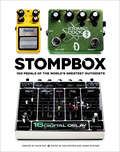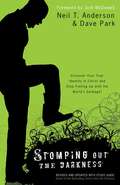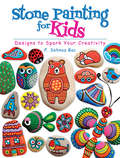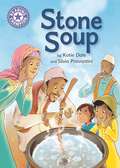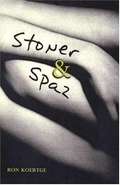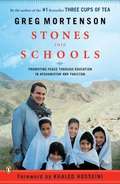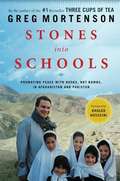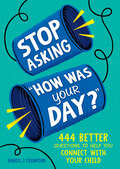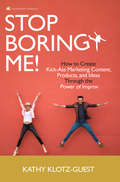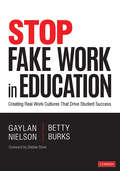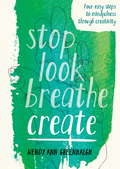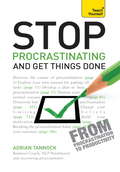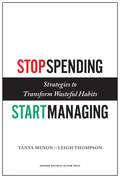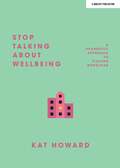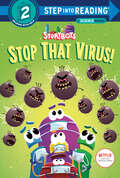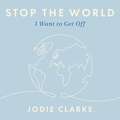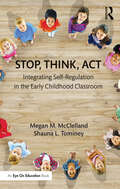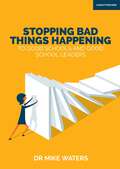- Table View
- List View
Stomp, Wiggle, Clap, and Tap: My First Book of Dance
by Rachelle BurkShake, rattle, and roll with this delightful dance book for children ages 1-3Toddlers are natural dancers, and they love to move! Release some of that endless toddler energy and help them develop balance and coordination with Stomp, Wiggle, Clap, and Tap. Moving along with the story will help stimulate little brains and provide a fun, creative way to build spatial awareness. Tons of colorful pictures offer toddlers visual clues for the movements, and the rhyming words make reading aloud feel like music.Movement and motor skills—Little ones will begin by learning to isolate individual body parts, like their hands, hips, arms, and toes, then move their whole body.Dynamic dancing—Toddlers will harness their imagination when they dance with silly moves like Prancing Pony, Flapping Chicken, and Twirling Pinwheel.Keep the fun going—Explore a list of online dance videos and resources to help them keep moving and developing even when the book is finished.Set the stage for an active childhood with this standout in books for toddlers.
Stompbox: 100 Pedals of the World's Greatest Guitarists
by Eilon PazA deluxe photographic celebration of the unsung hero of guitar music—the effects pedal—featuring interviews with 100 musicians including Peter Frampton, Joe Perry, Jack White, and Courtney Barnett.Ever since the Sixties, fuzz boxes, wah-wahs, phase shifters, and a vast range of guitar effects pedals have shaped the sound of music as we know it.Stompbox: 100 Pedals of the World&’s Greatest Guitarists is a photographic showcase of the actual effects pedals owned and used by Jimi Hendrix, Stevie Ray Vaughan, Frank Zappa, Alex Lifeson, Andy Summers, Eric Johnson, Adrian Belew, Joe Satriani, Steve Vai, Ed O&’Brien, J Mascis, Lita Ford, Joe Perry, Thurston Moore, Lee Ranaldo, Vernon Reid, Kaki King, Nels Cline and 82 other iconic and celebrated guitarists.These exquisitely textured fine-art photographs are matched with fresh, insightful commentary and colorfulroad stories from the artists themselves, who describe how these fascinating and often devilish devices shaped their sounds and songs.
Stomping Out The Darkness
by Neil T. Anderson Dave ParkThe pressure to look like the next cover girl, professional athlete or rock superstar can be intense for young people. Stomping Out the Darkness brings freedom with the reminder that no matter what we see when we look in the mirror, God sees something better. That's because God doesn't look at our faults and flaws. He accepts us for who we are right now, and He sees us as the people we can become. Anderson and Park show youth how to break free of all the garbage and negative thoughts that cloud their minds and how to discover the joy of being a child of God. On these pages, young men and women will discover that God has had a plan for their lives from the beginning of time-and, even though something went wrong with that plan, God has put everything back in order through Jesus. All you have to do is believe.
Stone Painting for Kids: Designs to Spark Your Creativity
by F. Sehnaz BacThis follow-up to the bestselling Art of Stone Painting offers a kid-friendly version of an engaging activity that helps promote creativity. Popular stone artist F. Sehnaz Bac, a seasoned archaeologist who markets her painted Sassi dell’Adriatico (Stones of the Adriatic) on Etsy, presents step-by-step instructions for simple projects, accompanied by full-color photographs. Her introduction explains how to find and choose stones, which kinds of materials and tools are safe for kids to use, how to set up a workspace, simple techniques, and other helpful tips.A splendid variety of patterns begins with illustrations of basic shapes and designs for human figures and faces, animals, numbers and letters, and natural motifs—flowers, trees, and stars. Other activities include painting stones for games such as tic-tac-toe, chess, and dominoes. Kids will learn lettering techniques for writing names and words on pebbles and how to design holiday-themed decorations. They'll also discover how to assemble multiple stones for picture-making and story-telling.
Stone Soup: Independent Reading Purple 8 (Reading Champion #628)
by Katie DaleThis story is part of Reading Champion, a series carefully linked to book bands to encourage independent reading skills, developed with Dr Sue Bodman and Glen Franklin of UCL Institute of Education (IOE)Stone Soup is a retelling of a classic tale of cleverness and working together. How will the mysterious stranger help the town come together and make delicious stone soup fit for a king?Reading Champion offers independent reading books for children to practise and reinforce their developing reading skills.Fantastic, original stories are accompanied by engaging artwork and a reading activity. Each book has been carefully graded so that it can be matched to a child's reading ability, encouraging reading for pleasure.
Stoner and Spaz
by Ron KoertgeFOR SIXTEEN-YEAR-OLD BEN BANCROFT a kid with cerebral palsy, no parents, and an overprotective grandmother, happiness is, watching Bride of Frankenstein for the umpteenth time.
Stones into Schools
by Greg MortensonFrom the author of the #1 bestseller Three Cups of Tea, the continuing story of this determined humanitarian's efforts to promote peace through educationIn this dramatic first-person narrative, Greg Mortenson picks up where Three Cups of Tea left off in 2003, recounting his relentless, ongoing efforts to establish schools for girls in Afghanistan; his extensive work in Azad Kashmir and Pakistan after a massive earthquake hit the region in 2005; and the unique ways he has built relationships with Islamic clerics, militia commanders, and tribal leaders. He shares for the first time his broader vision to promote peace through education and literacy, as well as touching on military matters, Islam, and women--all woven together with the many rich personal stories of the people who have been involved in this remarkable two-decade humanitarian effort.Since the 2006 publication of Three Cups of Tea, Mortenson has traveled across the U.S. and the world to share his vision with hundreds of thousands of people. He has met with heads of state, top military officials, and leading politicians who all seek his advice and insight. The continued phenomenal success of Three Cups of Tea proves that there is an eager and committed audience for Mortenson's work and message.
Stones into Schools: Promoting Peace with Books, Not Bombs, in Afghanistan and Pakistan
by Greg MortensonThe author of the #1 bestseller "Three Cups of Tea" offers the continuing story of this determined humanitarian's efforts to promote peace through education. Filled with rich, personal stories and insights into the Middle East, this book is an inspiration--and a call to action. (Proofreader's Note: There are a handful of map pages. I included all the verbal data on the maps. Photo descriptions included and checked. For large print readers or others who use it, the index was also carefully proofread and corrected as needed.)
Stones into Schools: Promoting Peace with Education in Afghanistan and Pakistan
by Greg MortensonFrom the author of the phenomenal No. 1 bestseller Three Cups of Tea, the continuing story of this determined humanitarian's efforts to promote peace through education. In this dramatic first-person narrative, Greg Mortenson picks up where Three Cups of Tea left off in 2003, recounting his relentless, ongoing efforts to establish schools for girls in Afghanistan; his extensive work in Azad Kashmir and Pakistan after a massive earthquake hit the region in 2005; and the unique ways he has built relationships with Islamic clerics, militia commanders, and tribal leaders even as he was dodging shootouts with feuding Afghan warlords and surviving an eight-day armed abduction by the Taliban. He shares for the first time his broader vision to promote peace through education and literacy, as well as touching on military matters, Islam, and women - all woven together with the many rich personal stories of the people who have been involved in this remarkable two-decade humanitarian effort.
Stop Asking "How Was Your Day?": 444 Better Questions to Help You Connect and Communicate with Your Child
by Daniel J. CrawfordWe've all been there: The kids come home from school tired and distracted, and we try to connect with them by asking the same questions day after day. Well, this book will help you find the right questions to connect with your child today and every day."How was school?" "What did you learn today?" "Did you have fun?" If we are lucky, we might get a little more than "Fine" or "It was good" in return. Maybe we're asking the wrong questions. The good news is that this book will help you find the right questions to connect with your child every day. Stop Asking "How Was Your Day?" is an invaluable tool that can be used again and again. Easy to flip through while waiting in the pickup lane outside school or before sitting down to dinner, this book provides diverse and open-ended questions for parents of schoolchildren of all ages and walks of life. Some questions are fun, some are thoughtful, and some are silly. Ultimately, this book is about communication.As we all know, communication is a two-way street, and Stop Asking "How Was Your Day?" alternates the queries with "Lead by Example" sections that prompt parents to share something from their own experiences to help them connect with their children
Stop Boring Me!: How to Create Kick-Ass Marketing Content, Products and Ideas Through the Power of Improv
by Kathy Klotz-GuestComing up constantly with a steady stream of marketing content, stories, and ideas that inspire excitement, interest and banish boring can be challenging. Your content-weary audience is saying "Stop Boring Me!" You cannot connect meaningfully with your audience if you bore them. There's just too much content chasing too little mindshare today. And most business marketing stinks because it is transactional, superficial and not human. The good news: it doesn't have to be that way because everyone is creative. Your inner kid is smart because it knows how to play. What if you could create engaging marketing content and storytelling, and generate kick-ass, fun and relevant ideas for stories, articles, branding, social media campaigns, sales presentations, and even new products? Well there is a fun way to do exactly that: by applying key concepts from the world of improvisation. Don't worry - this is not about theatricality, so you don't have to perform. It is about playfulness, however, and unleashing your inner kid. Bringing key concepts from the improvisation stage to your marketing, sales, branding and products page - or business stage, if you like - can help you, your team, your company and your business generate ideas that kick boring to the curb. While this book will help you be more funny, it's focused on fun as a creative catalyst for content idea orgasms: when different things come together in a fresh, human and engaging way that makes you and your audience say "aww yeah!" The first half of the book centers on how to use key improv concepts to craft and tell better stories for sales, social media, articles, presentations, content, and other story-related contexts. The second half of the book is all about innovating massively creative marketing ideas for products, content, campaigns, customer service, sales processes, you name it. While this book was written primarily for marketing people who have to create content, tell stories, make presentations; anyone in the idea-generation business (and who isn't) can use the tips in this book. Whether you are in marketing, sales, HR, product or customer service, these exercises will help you innovate and unleash more creative awesome into your work. Here is to more idea orgasms for you and your audience.
Stop Fake Work in Education: Creating Real Work Cultures That Drive Student Success
by Gaylan W. Nielson Betty BurksDon&’t do more work—do the right work. Hard work that yields the same old results can mire dedicated educators in exhaustion, burnout, and a lack of confidence that improvement is possible. When you offer your team a better way of working, planning, and collaborating, you turn Fake Work into Real Work—and stagnancy into dynamic change. Inside this data-driven, research-based guide, you&’ll find · The critical foundations for building a culture that drives maximum performance · A simple, three-part model for shedding Fake Work · Road maps for strategic planning, for aligning organizational strategies and actions, and for executing—seeing strategy translated into daily work. · Tools for gaining focus, building teams, and cultivating productive behaviors · Real educators&’ stories · Exercises, reflection questions, charts, checklists, and more
Stop Fake Work in Education: Creating Real Work Cultures That Drive Student Success
by Gaylan W. Nielson Betty BurksDon&’t do more work—do the right work. Hard work that yields the same old results can mire dedicated educators in exhaustion, burnout, and a lack of confidence that improvement is possible. When you offer your team a better way of working, planning, and collaborating, you turn Fake Work into Real Work—and stagnancy into dynamic change. Inside this data-driven, research-based guide, you&’ll find · The critical foundations for building a culture that drives maximum performance · A simple, three-part model for shedding Fake Work · Road maps for strategic planning, for aligning organizational strategies and actions, and for executing—seeing strategy translated into daily work. · Tools for gaining focus, building teams, and cultivating productive behaviors · Real educators&’ stories · Exercises, reflection questions, charts, checklists, and more
Stop Look Breathe Create
by Wendy Ann Greenhalghh3>Stop Look Breathe Create is a simple four-step process for exploring mindfulness through creativity, and in turn, developing creativity through mindful practice.The book engages the reader with ten everyday subjects, from 'The Ground Beneath Our Feet' to 'Returning Home' and for each of these there are three projects: one drawn, one photographic, one written. All are based on the effective mindfulness techniques that Wendy Ann has developed in her successful workshops and courses, and the book is filled with simple techniques and ideas to help the reader enjoy their artistic endeavours while being in the moment.A timely introduction to the benefits of mindfulness through creativity, Stop Look Breathe Create offers an oasis of calm in a frantic world.
Stop Look Breathe Create
by Wendy Ann Greenhalghh3>Stop Look Breathe Create is a simple four-step process for exploring mindfulness through creativity, and in turn, developing creativity through mindful practice.The book engages the reader with ten everyday subjects, from 'The Ground Beneath Our Feet' to 'Returning Home' and for each of these there are three projects: one drawn, one photographic, one written. All are based on the effective mindfulness techniques that Wendy Ann has developed in her successful workshops and courses, and the book is filled with simple techniques and ideas to help the reader enjoy their artistic endeavours while being in the moment.A timely introduction to the benefits of mindfulness through creativity, Stop Look Breathe Create offers an oasis of calm in a frantic world.
Stop Procrastinating and Get Things Done: Teach Yourself Ebook Epub
by Adrian TannockDo you ever find yourself putting off something that you need to do but you don't want to do? Even though you know you are doing it? And even though it makes you feel guilty? If so, you are one of millions of procrastinators, and this book can help you. Unlike other books on the subject, it starts by explaining the common causes of procrastination, which can range from the psychological (fear of failure, or performance anxiety) to the practical (the task is boring or repulsive). This understanding will form the first step of your journey from procrastination to productivity - a journey in which you will be accompanied all the way by Adrian Tannock, an ex-procrastinator who is now a prolific author and coach, with qualifications in hypnotherapy and NLP.
Stop Spending, Start Managing: Strategies to Transform Wasteful Habits
by Leigh Thompson Tanya MenonToo often, managers spend money to solve problems at work, whether that means hiring outside consultants, investing in new software to fix communication issues, or bribing employees with cash to motivate them. But many managers are surprised when the problem they tried to solve reappears a few months, weeks, or even days later. The money is gone, but the problem is still there. These costs can add up, particularly when you consider the additional loss to your company in wasted time, energy, and resources when you don’t solve problems effectively. Tanya Menon and Leigh Thompson, experts in how organizations work, have developed a framework to help you understand why you fall into this trap, and how to escape it. Five psychologies—each of which substitutes spending for your own powers of management—lead to wasteful spending: 1. Mindless spending: throwing money at a problem to avoid thinking about it; 2. Ego spending: squandering resources to make yourself look good; 3. Please-like-me spending: wasting time and money to avoid conflict; 4. Talk-to-me spending: buying expensive technologies to help people communicate; and 5. Follow-me spending: using financial incentives to motivate people To break these habits, Menon and Thompson show how you can use your smarts as a manager to find solutions. By consciously observing waste and identifying hidden value, widening your mind-set beyond ego, courageously negotiating with others, encouraging meaningful interaction, and transforming people with positive values and relationships rather than cash, you can overcome these psychological barriers and find the value that already exists in your
Stop Talking About Wellbeing
by Katherine HowardStop talking about wellbeing, and start taking action to own your workload. As the teacher retention crisis reaches breaking point, and mental health for teachers features regularly in the press, wellbeing has been pushed to the top of the national agenda in a bid for schools to consider how to look after their staff. However, wellbeing is becoming a tokenistic feature within the education sector, as staff participate in compulsory wellbeing-linked activities that have very little impact on their workload or ability to do what they came into the profession to achieve: inspiring young people. In a critical consideration of a range of educational research, Kat explores the key factors that form a teacher's role within school, outlining a range of ways that teachers can take ownership of their workload, and wellbeing through a sense of true job fulfilment. Interviewing expert teachers in their field and taking a Kat provides practical strategies for teachers at any point of their career to take away and implement immediately, in a bid to improve the educational landscape for teachers everywhere.
Stop Talking About Wellbeing
by Katherine HowardStop talking about wellbeing, and start taking action to own your workload. As the teacher retention crisis reaches breaking point, and mental health for teachers features regularly in the press, wellbeing has been pushed to the top of the national agenda in a bid for schools to consider how to look after their staff. However, wellbeing is becoming a tokenistic feature within the education sector, as staff participate in compulsory wellbeing-linked activities that have very little impact on their workload or ability to do what they came into the profession to achieve: inspiring young people. In a critical consideration of a range of educational research, Kat explores the key factors that form a teacher's role within school, outlining a range of ways that teachers can take ownership of their workload, and wellbeing through a sense of true job fulfilment. Interviewing expert teachers in their field and taking a Kat provides practical strategies for teachers at any point of their career to take away and implement immediately, in a bid to improve the educational landscape for teachers everywhere.
Stop That Virus! (Step into Reading)
by Scott EmmonsThe curious crew from Netflix's Ask the StoryBots star in an all-new Step into Reading leveled readerWhat is a virus? How do you catch a cold? Beep, Boop, and the rest of the robots from Netflix's Ask the StoryBots are looking for answers. The inquisitive team make this timely concern interesting, entertaining, and not-so-scary. Boys and girls ages 4 to 6 who love the StoryBots will enjoy this fun and educational Step 2 Step into Reading leveled reader.Step 2 Readers use basic vocabulary and short sentences to tell simple stories. For children who recognize familiar words and can sound out new words with help.
Stop the Lecturing Start the Conversation: Increasing Your Children's Emotional Intelligence
by Susan SidsworthThis book provides specific strategies for parents, teachers and caregivers who want to enhance the emotional and intellectual intelligence of children. Parents of toddlers often feel frustrated when they cannot communicate with their children in a positive way. Parents of pre-teens and teenagers often feel that their children are "tuning" them out. Many parents resort to lecturing or shouting in order to try and break through these communication barriers. This book aims to provide parents and educators with strategies for establishing a dialogue with children so that they are truly engaged in conversation and the learning process. Establishing a dialogue with children is crucial for our children's emotional, intellectual and social growth. When we establish dialogue or two -way communications with our children we are also part of the learning equation. We have many lessons to teach our children, but our children also have many lessons to teach us. Unfortunately, many of us are trapped in a monologue style of communication. We are telling our children what they can and can not do, we are explaining the rules, we are setting boundaries and we are often not listening to our children. Perhaps you want to protest at this point and say that you do listen to your children and that you try to patiently answer all of their questions. And children are generally asking many questions of the journalistic interrogation kind - Why? Where? When How? What? The fact that children are asking these questions is an indication of their quest to understand the world and the demands that it is making on them. But simply answering a child's questions - patiently or impatiently - is not a true dialogue. A dialogue occurs when two or more people engage in conversation about a subject or a decision and takes turns asking questions and listening to responses. The ideal Socratic Method involves the asking and answering of questions in order to stimulate critical thinking. The opposite of dialogue is a monologue. One person is speaking and others are supposed to be listening. Since monologues eventually become boring and non-engaging children eventually tune out their parents monologues. Many parents will finally exclaim in frustration "Am I talking to myself?" and resort to shouting or talking in an angry tone of voice to get their children's attention. Dialogue, on the other hand, is an engagement and an exchange between two people. This book will provide specific strategies to parents, teachers and caregivers that are designed to enhance the social, emotional and spiritual growth of children and young people.
Stop the World I Want to Get Off: A guide to understanding and supporting the recovery of autistic burnout in children and young people
by Jodie ClarkeWith mental health crisis in autistic young people on the rise we need to accept that Living as an autistic person in a world that doesn't cater to your needs is exhausting at best and harmful at worst.Autistic burnout is a common experience for autistic children and young people. This book, authored by a neurodivergent practitioner with firsthand experience as both an autism parent and researcher, delves into the recognition and management of burnout. It offers parents and professionals practical strategies to prevent autistic burnout and provides guidance on supporting those already in distress.For every child that has been forced into school in pyjamas, for every parent blamed for their child's non-attendance, for every professional who wants to learn more and for every young person traumatized by those who thought they knew best-this book is for you.
Stop, Think, Act: Integrating Self-Regulation in the Early Childhood Classroom
by Megan M. McClelland Shauna L. TomineyStop, Think, Act: Integrating Self-regulation in the Early Childhood Classroom offers early childhood teachers the latest research and a wide variety of hands-on activities to help children learn and practice self-regulation techniques. Self-regulation in early childhood leads to strong academic performance, helps students form healthy friendships, and gives them the social and emotional resources they need to face high-stress situations throughout life. The book takes you through everything you need to know about using self-regulation principles during circle time, in literacy and math instruction, and during gross motor and outdoor play. Each chapter includes a solid research base as well as practical, developmentally-appropriate games, songs, and strategies that you can easily incorporate in your own classroom. With Stop, Think, Act, you’ll be prepared to integrate self-regulation into every aspect of the school day.
Stopping Bad Things Happening to Good Schools - and Good School Leaders
by Mike WatersThis unique book has been written to save schools and their leaders from going belly-up. While no book can anticipate every possible horror situation, Mike Waters' book provides anyone who wants their school to steer clear of shocking events the guidance to do just that. But since such things can happen anyway, it is also about preparing and responding to them if they do occur. Think a school-harming won't happen to you or your school? They are happening more and more and often to the best schools and school leaders. Think your crisis management procedures will see you through? Don't bank on it. Many of the events that rock schools don't start off as obvious crises. They may start off as something seemingly minor and containable - a routine parental complaint, perhaps, or a stupid action by a member. Then things spiral out of control. That's the world that many school leaders find themselves in today. And if you want painful, first-hand evidence for this, you have only to read the school leaders' own accounts of their harrowing experiences provided in the book.Because Dr Waters' book draws directly on his experiences of working with schools rocked by crises they never saw coming, it is filled with practical wisdom. But it is also blessedly short. It's a book for busy people who want to save themselves stress and turmoil. If that's you, then read it before it's too late.
Stopping Bad Things Happening to Good Schools - and Good School Leaders
by Mike WatersThis unique book has been written to save schools and their leaders from going belly-up. While no book can anticipate every possible horror situation, Mike Waters' book provides anyone who wants their school to steer clear of shocking events the guidance to do just that. But since such things can happen anyway, it is also about preparing and responding to them if they do occur. Think a school-harming won't happen to you or your school? They are happening more and more and often to the best schools and school leaders. Think your crisis management procedures will see you through? Don't bank on it. Many of the events that rock schools don't start off as obvious crises. They may start off as something seemingly minor and containable - a routine parental complaint, perhaps, or a stupid action by a member. Then things spiral out of control. That's the world that many school leaders find themselves in today. And if you want painful, first-hand evidence for this, you have only to read the school leaders' own accounts of their harrowing experiences provided in the book.Because Dr Waters' book draws directly on his experiences of working with schools rocked by crises they never saw coming, it is filled with practical wisdom. But it is also blessedly short. It's a book for busy people who want to save themselves stress and turmoil. If that's you, then read it before it's too late.

